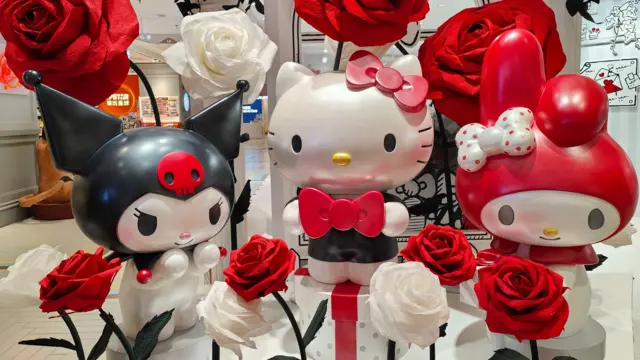Hello Kitty, Japan’s beloved icon, is celebrating her 50th anniversary, marking a half-century journey filled with highs and lows for Sanrio, the company behind her creation. Although Hello Kitty has become the world’s second-highest-grossing media franchise—surpassing giants like Mickey Mouse and Star Wars—Sanrio has grappled with fluctuating financial success as her popularity ebbed and flowed.

In recent years, Sanrio faced financial challenges as Hello Kitty’s appeal began to wane. Previous spikes in sales, like those in 1999 and 2014, were short-lived, says Yasuki Yoshioka of SMBC Nikko, describing Sanrio’s journey as a “rollercoaster.” The turning point came in 2020 when 31-year-old Tomokuni Tsuji, the founder’s grandson, became CEO, making him Japan’s youngest chief executive of a listed company. Under his leadership, Sanrio shifted its strategy to emphasize the company’s wider range of characters, rather than solely focusing on Hello Kitty.
This approach saw other Sanrio characters gain prominence, with Cinnamoroll—a blue-eyed puppy—now voted as Sanrio’s most popular character, replacing Hello Kitty. Tsuji emphasized that this shift wasn’t about lowering Hello Kitty’s status but about “boosting others’ recognition.”
Sanrio also adapted to modern tastes with characters like Aggretsuko, an angry red panda representing everyday workplace frustrations, and Gudetama, a “lazy egg” who embodies the darker realities of life. These fresh characters have attracted a younger, global audience, especially through platforms like Netflix.
To further expand its reach, Sanrio has boosted overseas marketing and tackled counterfeit products using AI. Collaborations with major brands such as Starbucks, Crocs, and the LA Dodgers have helped keep Sanrio’s characters visible year-round, Tsuji explained.
In Japan, family-run companies remain common, and Tsuji’s position as a Tsuji family member was instrumental in securing his role as CEO. Still, he admits he initially clashed with his grandfather on business direction, though eventually won his support. Within two years of Tsuji’s leadership, Sanrio achieved a “beautiful V-shaped recovery,” says Yoshioka, with shares surging tenfold and the company reaching a market valuation exceeding a trillion yen.
Hello Kitty’s legacy took an intriguing twist earlier this year when Sanrio executive Jill Koch revealed on US television that Hello Kitty “is not a cat” but a British schoolgirl. The revelation sparked social media debates, though Tsuji later explained, “Hello Kitty is whoever you want her to be.”
Reflecting on Hello Kitty’s British origin, Tsuji suggests the decision may have stemmed from London’s allure among Japanese girls at the time of her creation. While Hello Kitty’s backstory remains partly a mystery, her enduring appeal continues to captivate fans worldwide, a testament to her role as a cultural icon half a century on.
For more latest news and update visit UK Profits